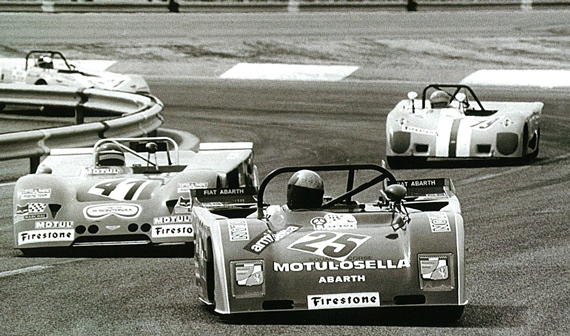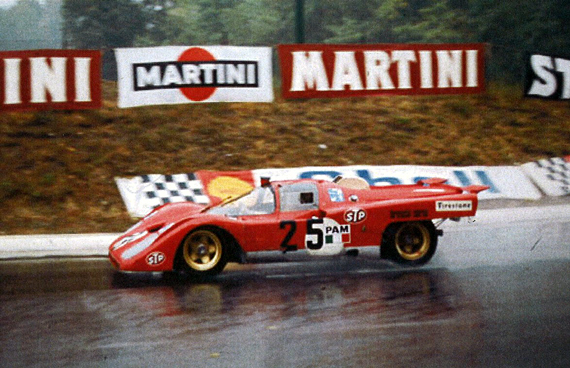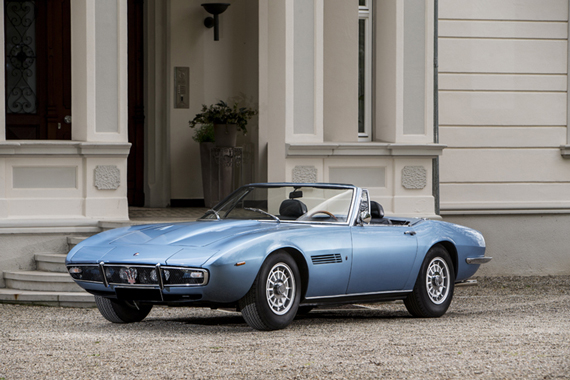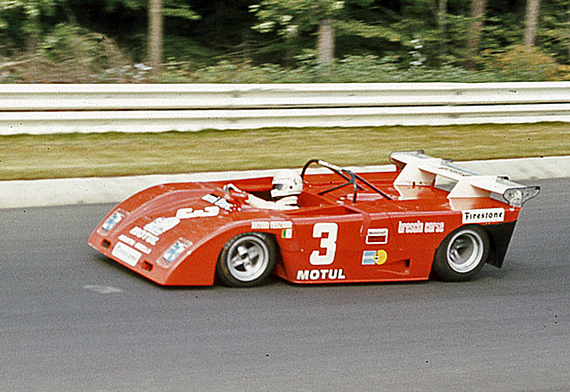
'Pam' in the Scuderia Brescia Corse Alfa T33. Note the car is painted with the colors of Scuderia. Credit Centro Documentazione Alfa Romeo
Part 2 of Brunori’s Brescia Corse follows the action as the team has its most successful season ever.
In 1971 two other fabulous cars joined the Brescia Corse garage; an Alfa Romeo 33 and a Ferrari 512 M, both personal purchases of Belponer. As Belponer revealed the day of the delivery when announcing the new Scuderia’s acquisitions, it was the sole Ferrari 512 sold to a private individual at the remarkable cost of 27 million lira, tires excluded.
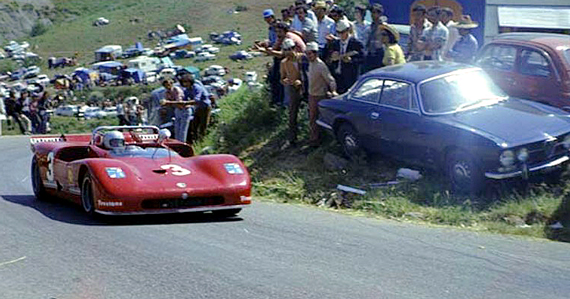
The team of Ferdinando Latteri and Nino Todaro in the Scuderia Brescia Course T33 at the Targa Florio in 1971. Credit Archivio Scuderia Brescia Corse
Brescia Corse also signed an agreement with Autodelta to borrow the services of Carlo Facetti when he’s free from official engagements, to drive the Chevron B 19 of the Scuderia. Casoni, Pam and Facetti also shared the 512 in the World Interseries Championship, racing at Monza, Imola, Zolder, Zwelteg, Norisring, Hockenheim. Our little club from Brescia was the sole private team to enter such a championship against the official team. Fighting with giants!
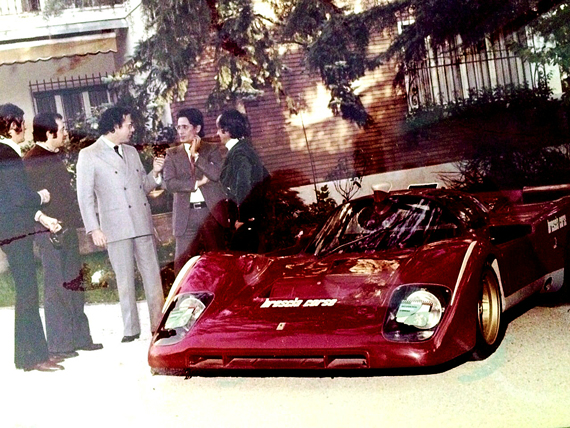
Belponer and the Ferrari 512, the picture taken in the garden of his house the day of presentation. Belponer with suit in center, next right 'PAM' Marsilio Pasotti and last Franco Loda, tech director of the team. Credit Archivio Scuderia Brescia Corse
There is also a story for Lambo’s aficionados. Belponer was a low-profile gentleman in town, but his name was well-known by supercar manufacturers and dealers. In 1971 the garage of Belponer’s house hosted a Maserati Ghibli Spyder, a Ferrari GTO, a Lamborghini Espada, a Aston Martin DB5, a Dino 246 GTS, a Rolls Royce and a Mercedes 6.3L. One morning he received a phone call from Gerino Gerini of Lambocar, the official dealer in Bologna, advising that there is a Miura, the fastest Miura ever built, available for him to join his fabulous collection.
The car is chassis # 5084, the famous Jota, developed by Bob Wallace as a testing laboratory with racing in mind, but rejected by Ferruccio, who absolutely refused to manufacture any racing version of his cars. The agreement was signed and the car was delivered to Interauto, the dealer in Brescia, for collection on April, 12th 1971. InterAuto was owned by Enrico Pasolini, one of the pilots of the Scuderia. Pasolini and one of his salesman called Fausto Pedrinelli asked to test the Jota and Belponer, not having even sat in the car, agreed and sent the Scuderia mechanic Mario Faita on the external ring road of the town to meet the two drivers. The ring road had been completed (but not yet open to the public), and the two jumped in the car and took off at full throttle. On the end of the first lap the speedometer indicated 330Km/h, but on the way back the car hit a curb, flew high, and landed on a bank, completely destroyed. The two friends, one with a broken arm and the other lightly injured, barely had time to leave the wreck before the fire started, reducing the Jota in a pile of smoking debris within a couple of minutes. The story of the Jota too has to do with Brescia!*See notes below
Without any doubt the golden year of Brescia Corse was 1972. Arturo Merzario and Toine Hezemans joined the team. Merzario won five O/A victories in eight races with the Abarth Osella 2000 SP, and delivered to Abarth and Brescia Corse the title of the European Manufacturers Championship. The same title of European Hillclimb Champion in Group 5 goes to Franco Pilone, with a similar car. To honor this, the badge of Scuderia added a blue stripe with 13 golden stars as the emblem of European Community.
Victories kept on coming: 12 O/A, and 130 class wins and seven Italian titles. There was no place in Europe where the name Brescia Corse was unknown, and the secretary had to do his best to satisfy all the requests of badges and stickers coming from all the fans.
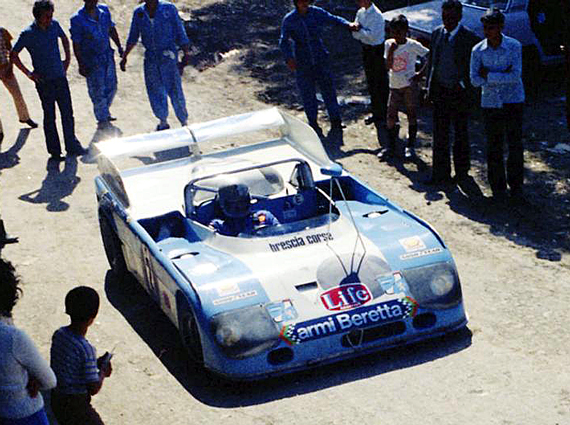
'Pam'/Zeccoli Alfa T33. Picture taken during trials at Targa Florio in 1973. Car did not start due to oil leak. Credit Vittorio Giordano/Archivio Manzo
The following year another landmark car arrived at the Scuderia – an Alfa Romeo 33 TT 3, which included a semi-official partnership with Autodelta for the World Championship. The car, at some point painted white and blue, was driven by “Pam” and Facetti. It entered most of the races, including Hockenheim, the Targa Florio, Vallelunga and placed 5th at Monza, 15th at Le Mans and 7th at Zwelteg, gaining 12 points for Alfa in WSC.
But, as Bob Dylan put it, “the times they are a changing”, and from the 1974 season the decline began. The fans were more interested in rallies, the rules changed each year, the happy days were gone, and even worse, Belponer was facing a financial disaster. His company went into bankruptcy; in the previous years he wasted all his real estate fortune, selling flats and buildings one after the other, to finance the Scuderia.
After the 1977 season Brescia Corse is finished, and Belponer retires in a flat on the Tuscany coast, cutting every connection with Brescia and his old buddies.
But, as before said, fire is smoldering in the ashes. One day in the spring of 1994 Belponer received a phone call from his first vice president, Ugo Gussalli Beretta. A group of friends who are active in historic racing have gathered around Beretta, who explained to Belponer the desire of these friends to revive the never-forgotten name of Scuderia Brescia Corse. Belponer was surprised and delighted of this request and gave his approval, leaving the name in the hands of these new/old friends, happy to see his badge up on the shields again until his death at 80, in 2009.
* We found some information about the Jotta in Joe Sackey’s “Lamborghini Muira Bible”, but Brunori has these observations:
Was Pasolini involved in a race? Not true
Was Pasolini a modest driver not used to fast cars? His career indicates otherwise: in 72 he was 4th O/A in a Lola at Targa Florio, 1st O/A in an Abarth 1000 at Varano, 1st O/A in the Cividale hillclimb with the Abarth 1000, at Le Mans with the Pantera and at Vila Real with the Lola dnf.
Enrico Pasolini confirmed that he was at the wheel. This exactly what happened: First leg Enrico drove, passing 200 km/h he found the car very unstable and difficult to keep on the road. On the way back Pedrinelli was driving but after a couple of miles he found the game too hazardous and returned the wheel to Pasolini. The crash happened at 240 km/h
Were there no witness? Not true – Faita the mechanic was there.
Read Part 1 Scuderia Brescia Corse
Next in Part 3; Scuderia Brescia Corse revived.
